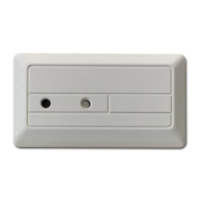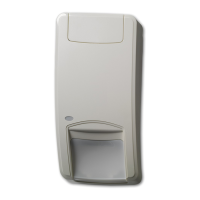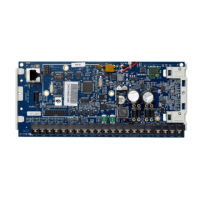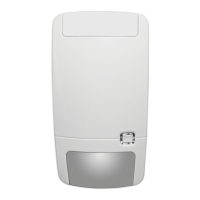4 / 14 P/N 422-6367-ML • REV E • ISS 03DEC18
Glass type of pane
inside room
Double glazed
with security
film
Closing the detector
To close the detector, follow these steps:
1. Insert cover hooks into slots in the base (Figure 7, item 1)
2. Close the cover (item 2)
3. Tighten the locking screw (item 3)
4. Slide down the lock cover (item 4)
Check the settings with GS960-TR tester
If the detector is placed too far or too close from the glass, it
will not respond. At DRC testing the LED of the detector will
flash 1, 2 or 3 times to show it is in a certain Zone. If it does not
flash a better place must be selected.
1. Put the cover on and make sure it hooks properly into the
base of the detector.
2. Apply power. LED will now indicate your range setting by
blinking 1 to 3 times.
3. Use GS960-TR to test and calibrate the detector for
optimal position.
Testing and calibrating
GS960-TR tester is a specially developed tool for calibrating
and adjusting the detector GS960 for optimal function in the
acoustic room – the DRC Digital Room Compensation
procedure. When testing the detector settings you do not need
to open it again as the tester will communicate with the
detector acoustically. Never test the GS960 with a cover
disassembled from a base. Make sure the cover is fastened
properly.
Caution: Do not use the GS960-TR tester in proximity to your
ears as the tester produces loud noises.
Digital room compensation procedure
Prepare the acoustic detector for DRC by setting the D/N line
(if used) in DAY mode – D/N line should be left open or Low.
1. Press the START button of the GS960-TR tester to put the
power on. Green LED will light.
2. Hold the tester 1 to 3 m from the detector and aim the
speaker at it.
3. Press the START button once more to initiate the DRC
mode. The LED on the detector will start to flicker. See
Figure 8.
4. Go to the furthest distance (max. 9 m) of the glass to be
protected and aim the speaker at the detector. See
Figure 9.
The DRC range calculated by the detector will be
displayed as a number of pulses from 1 to 3.
5. Press the DRC button to send a DRC signal out. Make this
2 to 10 times from different angles of the protection area
for optimal capability. The LED will flash confirming it has
received the signal. The LED will then start to blink and
flicker. The DRC range calculated by the detector will be
displayed as a number of pulses from 1 to 3. In case of too
weak or too strong signals outside the compensation
range (means that the detector is placed too close or too
far from the object to be protected), the detector will then
not show DRC range.
6. Press the STOP button from a distance of 1 to 3 m from
the detector to terminate the DRC procedure.
If DRC range measured by the detector is different from actual
DIP switch settings, the LED will continue to blink 1 to 3 times
showing the correct range number to be set in the detector.
• The LED blinks 1 time: set to Zone 1 (4 to 9 m)
• The LED blinks 2 times: set to Zone 2 (2 to 4 m)
• The LED blinks 3 times: set to Zone 3 (1 to 2 m)
Protecting several windows by one detector
Detector can protect several windows in one room if the
windows are within the coverage area. Make independent DRC
test for each window to be protected. Follow the procedure
above for each window. The detector shall be set to the lowest
Zone number that is the longest range from the detector.
Timeout
Both the GS960 detector and GS960-TR tester are equipped
with a timeout feature. The GS960 will stop the DRC mode and
the GS960-TR will switch off power if no activity has happened
within 3 to 4 minutes.
D/N control (Day/Night)
The D/N makes it possible to remote control the alarm
indications of the detectors and remote reset during DAY-
>NIGHT transition. The D/N increases the security of the
detector, as it enables the alarm indications to be concealed in
NIGHT mode without any influence on the relay function.
Self-test
Detector is continuously checking all vital parts responsible for
proper detection of glass break signal using internal self-test
procedure.

